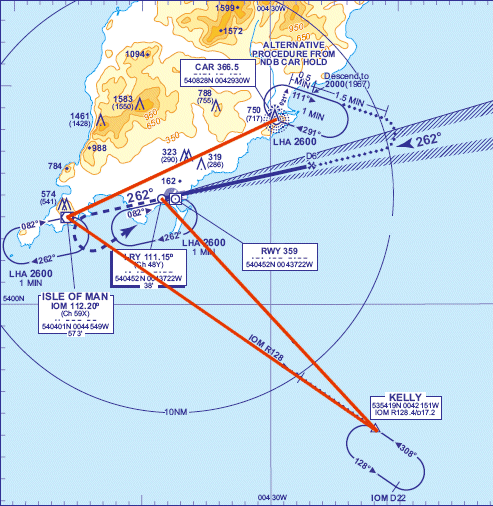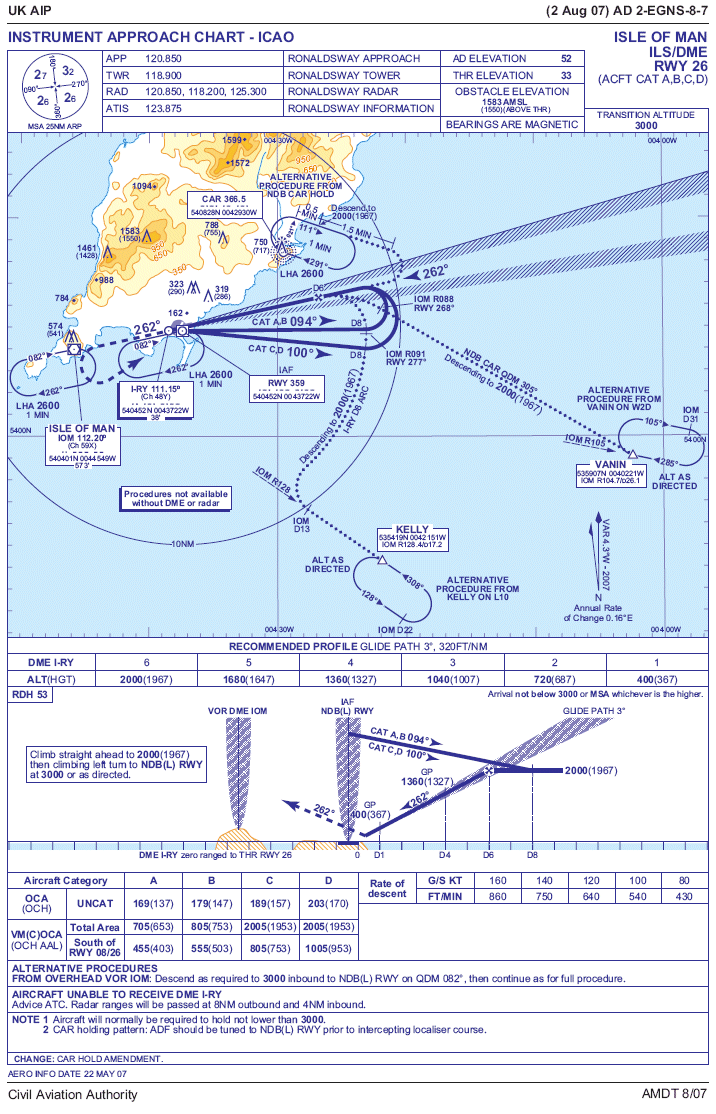






Procedural Instrument Approaches
Part 2
Before we start
Before we look at a specific procedure - in this case the ILS/DME approach to runway 26 - a word of advice regarding ATC.
Despite
rumours to the contrary ATC are not mind readers. If you are inbound to
an airfield then ATC will normally radar vector you to the ILS for the
runway in use. If you want to fly a procedure you need to tell them.
For a start I would advise that you put in the remarks column of the flight
plan:
RMK/INSTRUMENT TRAINING
Secondly, on initial contact with approach control, you should inform them of the training you would like to carry out. You should say that you wish to fly the procedural ILS approach for 26 and specify the point at which you wish to commence this procedure - as I will show below there are five possible holds from which the procedure can begin.
Telling ATC that you wish to fly a procedure informs them that you want to fly the approach yourself and do not require radar vectoring. ATC will try to accommodate this but a procedural training approach is always subject to other traffic - ATC may decline the request, offer an alternative or suggest delaying until traffic has eased off (a delay usually meaning going into a holding pattern). ATC may also accept your request but give you initial radar vectoring to provide separation for other aircraft - but will put you back on your own navigation as soon as possible.
Flying the ILS
The ILS plates for most airfields are quite basic and there may be only one procedure to fly. The ILS at Ronaldsway has five procedures from five different stacks and all are different. They are:
1. A DME arc procedure from KELLY.
2. An NDB intercept from VANIN.
3. The direct procedure from overhead the RWY NDB.
4. A procedure from the IOM VOR.
5. An offset NDB intercept from CAR NDB.
Different skills are required for all these approaches and most requires the ILS setting up on NAV1 whilst flying the aircraft from the VOR on NAV2 or tracking an NDB on the ADF. Good cockpit discipline is necessary for any procedural approach.
From the time you leave a holding pattern you should pay particular attention to speed. Procedures are based on rate 1 turns and if flown at excessive speeds you will never achieve the designed paths. Aircraft should never fly a holding pattern above 210kts and it follows that all procedures require the aircraft to be at this speed or less.
Below I will describe each of the five procedures.
From VANIN
This is the easiest of the five approaches. Aircraft inbound to EGNS on W2D from POL VOR are normally cleared to VANIN at FL45 or FL50. As you can see from the plate above, having been cleared for the procedural approach you would:
Track from VANIN to CAR NDB. A no wind heading would be 305 (shown on the chart as QDM305). After leaving VANIN you would also descend to 2000ft QNH (1967ft QFE).
As you reach IOM radial 088 (or RWY QDM268) you should start seeing the Localiser needle become active and a turn should be made to capture the ILS.
2000ft should be maintained until 6 DME (the FAF). If the approach is stable you then descend on the glidepath but if the approach is not stabilised at FAF it should be discontinued.
Although a simple approach there are several points you should be made aware of. First is that on leaving VANIN you tune NAV1 to the ILS. ADF should be tuned to CAR and it is this instrument that becomes your prime navigational source as you track to the NDB. As you leave VANIN you also start descending to 2000ft and so aircraft management (especially speed) should be under complete control. You should never intercept an ILS higher than 160-180kts.
In FS you don't have two ADF's so it is impossible to tune to RWY NDB to get the 268QDM marker to signal the ILS activating. The only option here is to tune NAV2 to IOM VOR and use the 088 radial as the guide. I need not add that you are now using all three nav sources for data - tracking directly from the ADF whilst watching the NAV2 needle to centre which should indicate the ILS becoming active.
Once you establish on the ILS the rest of the procedure is as you have flown many times before.
From IOM VOR
Aircraft from Dublin (on W911D), Glasgow (on W928D) or Belfast (on L10) will normally be cleared to the IOM VOR at 3000ft.
On reaching the VOR you fly directly to the RWY NDB.
Leave the RWY NDB on a track of 094 (for Cat A and B aircraft) or 100 (Cat C and D) aircraft. You should know your category after checking the CAA pages.
As you leave the RWY NDB you also descend to 2000ft QNH.
At 8 DME IRY you start a Rate 1 turn to the left to intercept the ILS.
Again there are cautionary comments to make. Before reaching the IOM VOR you should have RWY NDB tuned on the ADF ready to turn direct to the NDB. You should also retune NAV1 to the ILS as soon as you leave the VOR. Having run out to 8 DME on the outbound leg of the procedure, unless you have corrected for wind, your turn onto the ILS may undershoot or overshoot the centreline - be prepared for this. If you have forgotten to retune NAV1 to the ILS it will mean that when you start your turn at 8 DME you are still reading this from the IOM VOR and will only be 3.5nm from the airfield - the approach will then go horribly wrong!
From RWY NDB
This is almost identical to the IOM procedure above except you will be going directly out on the procedure. The only caution with this approach is that if you are flying direct to the NDB before starting the approach you may need to fly an intermediate teardrop pattern to ensure you establish on the correct outbound heading. I will describe teardrops later.
From KELLY
Aircraft from Manchester, London and the SE on L10 will normally be cleared to KELLY at FL80.
Leave KELLY on track to the IOM VOR and begin descent to 2000ft QNH.
At 13 DME IOM turn right to fly the 8 DME arc from IRY DME.
As you reach IOM radial 091 start a left turn to intercept the ILS.
Lots of traps for this approach. The first is when you are past KELLY and flying towards the IOM. At DME 13 you begin a turn to the right to pick up the 8 DME arc from IRY and with the VOR on NAV1 this means the ILS will be on NAV2. Plan ahead here and before you get to KELLY tune NAV2 to the VOR, switch to HDG mode and then tune NAV1 to the ILS. Watch for 13 DME on NAV2 and then, once you start the turn, all your flying is now on NAV1 whilst you fly the arc and capture the ILS. You are not finished with NAV2 though - reset the OBS to 091 and watch for the needle to centre whilst flying the arc as this is the mark for your turn onto the ILS.
For most of this procedure you are descending and turning at the same time - this is not normal for the other procedures above and may feel odd.
From CAR NDB
Left to last as this procedure can only be flown from the CAR holding pattern. CAR is no longer part of any airway and so this procedure is only used for training purposes. The chart shows the LHA (Lowest Holding Altitude) as 2600ft but it is more normal to fly the hold at 3000ft. Read the chart carefully and compare with the instructions below.
As you pass overhead CAR on 291 you begin a right turn onto 111. Start the stopwatch as you pass over the NDB.
After 1 minute (Rate 1 turn) you should be on heading 111 and abeam the NDB.
After a further 30 seconds (total 1:30 on stopwatch) start a descent to 2000ft.
After another 1min 30 sec (total 3:00 on stopwatch) turn right to intercept the ILS.
Timing is everything with NDB holds so a stopwatch is a very useful item. You cannot fly this procedure without one, even in FS.
Training Routes
All the above can be flown individually but a variety of techniques can be practised with a good training route. The chart below shows a typical base check route for the Isle of Man. The route is as follows.
After departure fly to KELLY, reverse course and route KELLY - IOM. At IOM turn to CAR NDB and enter the hold. Fly the hold twice and then fly the alternate procedure for the ILS.

Although it looks simple on paper the route tests several disciplines. It requires both NDB and VOR tracking, flying over a position and reversing course on a specific radial, flying an NDB holding pattern and, finally, completing a procedural ILS.
At the end of this exercise the aircraft would go around at minima and climb out for a second ILS approach or a VOR/DME approach onto Rwy 08.
We haven't discussed teardrops yet so I will continue with these on the next page.


